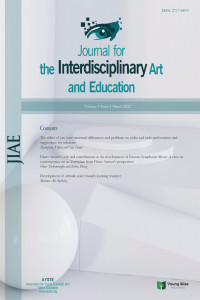The uniqueness of Cantonese opera in Hong Kong: contributions and influence by Tong Tik-sang
The uniqueness of Cantonese opera in Hong Kong: contributions and influence by Tong Tik-sang
cantonese opera, tong tik-sang, operas, hong kong chinese operas,
___
- Chan, Kar Yue. “Cross-Dressing and Gendered Voice Representation in Cantonese Opera.” Comparative Literature: East & West 3, no. 1 (June 2019): 1-14. DOI: 10.1080/25723618.2019.1615727.
- Ching, May Bo. “Where Guangdong Meets Shanghai: Hong Kong Culture in a Trans-regional Context.” In Hong Kong Mobile: Making a Global Population, edited by Siu Helen F. and Ku Agnes S., 45-62. Hong Kong: Hong Kong University Press, 2008. www.jstor.org/stable/j.ctt1xwgdb.10.
- Chiu, Yvonne and Andrew Kwong. “Behind the Colored Mask: An Introduction to the Traditions of Cantonese Opera.” Opera Canada 36, no.1 (Spring, 1995):12-13.
- Chow, Sze Sum. “Tradition and innovation: adaptation in Cantonese opera.” PhD diss., University of Hong Kong Baptist University, Hong Kong, 2016. https://repository.hkbu.edu.hk/cgi/viewcontent.cgi?article=1288&context=etd_oa.
- City University of Hong Kong. “Glamour of Cantonese Opera: An Introduction.” Run Run Shaw Library, City University of Hong Kong. Last modified June 11, 2020. http://www.cityu.edu.hk/lib/about/event/cantonese_opera/hkopera.htm.
- Duhalde, Marcelo, Jing Tian Yan, and Dennis Wong. “Cantonese Performing Art.” South China Morning Post, November 8, 2019. https://multimedia.scmp.com/infographics/culture/article/3036661/cantonese-opera/index.html.
- Ferguson, Daniel Lee. A Study of Cantonese Opera: Musical Source Materials, Historical Development, Contemporary Social Organization, and Adaptive Strategies. PhD diss., University of Washington, Washington,1988. ProQuest Dissertations & Theses Global.
- Hong Kong Heritage Museum. “Splendour of Cantonese Opera: Masters Tong Tik Sang and Yam Kim Fai.” Last modified, 2014. https://www.heritagemuseum.gov.hk/documents/2199315/2199693/Splendour_of_Cantonese_Opera-E.pdf.
- Hong Kong Heritage Museum. “The Majestic Stage: The Story of Cantonese Opera Theatres.” Last modified, 2014. https://hk.heritage.museum/documents/2199315/2199693/The_Majestic_Stage-E.pdf. Judkins, Benjamin N., and Jon Nielson. The Creation of Wing Chun: A Social History of the Southern Chinese Martial Arts. Albany, NY: State University of New York Press.
- Leung, Janice. “Cantonese opera traditions must be protected as it Modernises.” South China Morning Post, December 16, 2014. https://www.scmp.com/lifestyle/arts-culture/article/1662942/cantonese-opera-traditions-must-be-protected-it-modernises.
- Liu, Jingzhi劉靖之. Hong Kong Music History: Cantonese Popular Code, Serious Music, Cantonese Opera香港音樂史論:粵語流行曲,嚴肅音樂,粵劇. Hong Kong: The Commercial Press, 2013.
- Ng, Wing Chung. The Rise of Cantonese Opera. Illinois: University of Illinois Press, 2015.
- Patrimonio Cultural de Macao. “Elements of Intangible Cultural Heritage: Yueju Opera (Cantonese Opera).” Last modified 6/12/2020. http://www.culturalheritage.mo/en/detail/140/1.
- Sang, Tong Dik, Bell Yung, Sonia Ng, and Katherine Carlitz. "Introduction." In The Flower Princess: A Cantonese Opera by Tong Dik Sang, 1-24. Hong Kong: Chinese University Press, 2010. www.jstor.org/stable/j.ctt1pc5dk7.7.
- Tai, Suk Yan. “A Study on Tang Di-Sheng's Cantonese Opera Works of the 1950s.” PhD diss., The Chinese University of Hong Kong, Hong Kong, 2007. ProQuest Dissertations & Theses Global. “中國古典樂曲欣賞—妝台秋思.” The Epoch Times, November 4, 2010. https://www.epochtimes.com/b5/10/11/4/n3074822.htm
- Yung, Bell. “A Heuristic Theory of Metrical Transformation and Tune Metamorphosis: Tracking Creativity in Traditional Cantonese Opera.” Ethnomusicology 64, no. 1 (2020): 110-40.
- Yung, Bell. “Creative Process in Cantonese Opera I: The Role of Linguistic Tones.” Ethnomusicology 27, no. 1 (1983): 29-47.
- Websites:
- Web 1. https://www.bbc.com/travel/article/20120813-cantonese-opera-returns-to-hong-kong
- Web 2. https://welcometochina.com.au/a-new-global-mega-city-like-no-other-guangdong-hong-kong-macao-greater-bay-area-5489.html
- Web 3. http://www.cityofzhuhai.com/2022-02/16/c_707478.htm
- Web 4. https://cducomb.colgate.domains/globaltheater/asia/makeup-in-cantonese-opera/
- Web 5. https://www.bankofchina.com/mo/en/bocinfo/bi1/201403/t20140314_3046887.html
- Yayın Aralığı: Yılda 4 Sayı
- Başlangıç: 2020
- Yayıncı: Genç Bilge Yayıncılık
Russian romance: synthesis of classical and folk music at the beginning of the 19th century
Olga GUSEYNOVA, Ömer TÜRKMENOĞLU
Performance, impact and recommendations for video-assisted violin education
The uniqueness of Cantonese opera in Hong Kong: contributions and influence by Tong Tik-sang
Ömer TÜRKMENOĞLU, Faruk MEHINAGIÇ
A look at the history and musical culture of the peoples living in the territory of Azerbaijan
